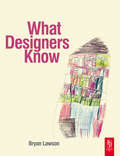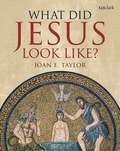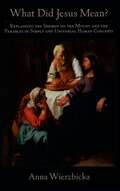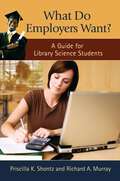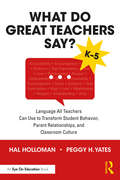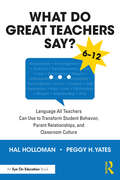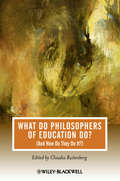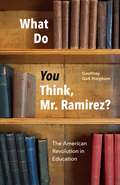- Table View
- List View
What Designers Know
by Bryan LawsonEach chapter deals with a different technique from which we can best represent and make explicit the forms of knowledge used by designers. The book explores whether design knowledge is special, and attempts to get to the root of where design knowledge comes from. Crucially, it focuses on how designers use drawings in communicating their ideas and how they ‘converse’ with them as their designs develop. It also shows how experienced designers use knowledge differently to novices suggesting that design ‘expertise’ can be developed. Overall, this book builds a layout of the kinds of skill, knowledge and understanding that make up what we call designing.
What Did Jesus Look Like?
by Joan E. TaylorJesus Christ is arguably the most famous man who ever lived. His image adorns countless churches, icons, and paintings. He is the subject of millions of statues, sculptures, devotional objects and works of art. Everyone can conjure an image of Jesus: usually as a handsome, white man with flowing locks and pristine linen robes.But what did Jesus really look like? Is our popular image of Jesus overly westernized and untrue to historical reality?This question continues to fascinate. Leading Christian Origins scholar Joan E. Taylor surveys the historical evidence, and the prevalent image of Jesus in art and culture, to suggest an entirely different vision of this most famous of men. He may even have had short hair.
What Did Jesus Look Like?
by Joan E. TaylorJesus Christ is arguably the most famous man who ever lived. His image adorns countless churches, icons, and paintings. He is the subject of millions of statues, sculptures, devotional objects and works of art. Everyone can conjure an image of Jesus: usually as a handsome, white man with flowing locks and pristine linen robes.But what did Jesus really look like? Is our popular image of Jesus overly westernized and untrue to historical reality?This question continues to fascinate. Leading Christian Origins scholar Joan E. Taylor surveys the historical evidence, and the prevalent image of Jesus in art and culture, to suggest an entirely different vision of this most famous of men. He may even have had short hair.
What Did Jesus Mean?: Explaining The Sermon On The Mount And The Parables In Simple And Universal Human Concepts
by Anna WierzbickaWhat Do Employers Want?: A Guide for Library Science Students
by Priscilla K. Shontz Richard A. MurrayA candid, comprehensive, and insightful explanation of what library school students need to do in order to maximize their chances of getting a professional position immediately after graduation.While library schools provide graduates with a solid understanding of library science concepts, many diploma holders have no clear plan for finding a desirable job with their knowledge The information in What Do Employers Want? A Guide for Library Science Students will be extremely valuable for students currently in Masters of Library Science program as well as recent recipients of MLS degrees, regardless of what kind of work environment they wish to work in.The book guides readers through the process of planning a job search step-by-step. Divided into two major sections—the student experience and the job search—the authors provide critical advice derived from their combined 30 years of real-world, in-the-field experience. Specific topics include choosing classes, gaining practical experience while in school, establishing a professional image, gaining skills that make applicants more marketable, writing effective resumes and cover letters, interviewing, and negotiating a job offer.
What Do Employers Want?: A Guide for Library Science Students
by Priscilla K. Shontz Richard A. MurrayA candid, comprehensive, and insightful explanation of what library school students need to do in order to maximize their chances of getting a professional position immediately after graduation.While library schools provide graduates with a solid understanding of library science concepts, many diploma holders have no clear plan for finding a desirable job with their knowledge The information in What Do Employers Want? A Guide for Library Science Students will be extremely valuable for students currently in Masters of Library Science program as well as recent recipients of MLS degrees, regardless of what kind of work environment they wish to work in.The book guides readers through the process of planning a job search step-by-step. Divided into two major sections—the student experience and the job search—the authors provide critical advice derived from their combined 30 years of real-world, in-the-field experience. Specific topics include choosing classes, gaining practical experience while in school, establishing a professional image, gaining skills that make applicants more marketable, writing effective resumes and cover letters, interviewing, and negotiating a job offer.
What Do Great Teachers Say?: Language All Teachers Can Use to Transform Student Behavior, Parent Relationships, and Classroom Culture K-5
by Hal Holloman Peggy H. YatesDo you remember a time when you used the right words at the right moment, and they made all the difference? With the aim of helping you repeat that experience every day, this book provides hundreds of examples of what we call Great Teacher Language, a technique designed to help all teachers use words to transform student behavior and parent relationships. In their years of working at the K-12 levels, educators Hal Holloman and Peggy H. Yates have identified the exact phrases and key words you can use in your classroom to address inappropriate outbursts, a lack of respect and cooperation, student conflict, and more. Great Teacher Language will enable you to transform student behavior, parent relationships, and your classroom culture. This book features 11 Great Teacher Language Word Categories, which you'll learn how to use in terms of self-talk, student talk, and parent talk: Words of Accountability, Words of Encouragement, Words of Grace, Words of Guidance, Words of High Expectations, Words of Hope, Words of Love, Words of Relationships, Words of Respect, Words of Understanding, and Words of Unity. Filled with helpful charts and Great Teacher Language examples, this resource will be one you turn to again and again, and will make a transformational difference for your students, your parents, and you!
What Do Great Teachers Say?: Language All Teachers Can Use to Transform Student Behavior, Parent Relationships, and Classroom Culture K-5
by Hal Holloman Peggy H. YatesDo you remember a time when you used the right words at the right moment, and they made all the difference? With the aim of helping you repeat that experience every day, this book provides hundreds of examples of what we call Great Teacher Language, a technique designed to help all teachers use words to transform student behavior and parent relationships. In their years of working at the K-12 levels, educators Hal Holloman and Peggy H. Yates have identified the exact phrases and key words you can use in your classroom to address inappropriate outbursts, a lack of respect and cooperation, student conflict, and more. Great Teacher Language will enable you to transform student behavior, parent relationships, and your classroom culture. This book features 11 Great Teacher Language Word Categories, which you'll learn how to use in terms of self-talk, student talk, and parent talk: Words of Accountability, Words of Encouragement, Words of Grace, Words of Guidance, Words of High Expectations, Words of Hope, Words of Love, Words of Relationships, Words of Respect, Words of Understanding, and Words of Unity. Filled with helpful charts and Great Teacher Language examples, this resource will be one you turn to again and again, and will make a transformational difference for your students, your parents, and you!
What Do Great Teachers Say?: Language All Teachers Can Use to Transform Student Behavior, Parent Relationships, and Classroom Culture 6-12
by Hal Holloman Peggy H. YatesDo you remember a time when you used the right words at the right moment, and they made all the difference? With the aim of helping you repeat that experience every day, this book provides hundreds of examples of what we call Great Teacher Language, a technique designed to help all teachers use words to transform student behavior and parent relationships. In their years of working at the K-12 levels, educators Hal Holloman and Peggy H. Yates have identified the exact phrases and key words you can use in your classroom to address inappropriate outbursts, a lack of respect and cooperation, student conflict, and more. Great Teacher Language will enable you to transform student behavior, parent relationships, and your classroom culture.The book features 11 Great Teacher Language Word Categories, which you'll learn how to use in terms of self-talk, student talk, and parent talk: Words of Accountability, Words of Encouragement, Words of Grace, Words of Guidance, Words of High Expectations, Words of Hope, Words of Love, Words of Relationships, Words of Respect, Words of Understanding, and Words of Unity.Filled with helpful charts and Great Teacher Language examples, this resource will be one you turn to again and again and will make a transformational difference for your middle and high school students, their parents, and you!
What Do Great Teachers Say?: Language All Teachers Can Use to Transform Student Behavior, Parent Relationships, and Classroom Culture 6-12
by Hal Holloman Peggy H. YatesDo you remember a time when you used the right words at the right moment, and they made all the difference? With the aim of helping you repeat that experience every day, this book provides hundreds of examples of what we call Great Teacher Language, a technique designed to help all teachers use words to transform student behavior and parent relationships. In their years of working at the K-12 levels, educators Hal Holloman and Peggy H. Yates have identified the exact phrases and key words you can use in your classroom to address inappropriate outbursts, a lack of respect and cooperation, student conflict, and more. Great Teacher Language will enable you to transform student behavior, parent relationships, and your classroom culture.The book features 11 Great Teacher Language Word Categories, which you'll learn how to use in terms of self-talk, student talk, and parent talk: Words of Accountability, Words of Encouragement, Words of Grace, Words of Guidance, Words of High Expectations, Words of Hope, Words of Love, Words of Relationships, Words of Respect, Words of Understanding, and Words of Unity.Filled with helpful charts and Great Teacher Language examples, this resource will be one you turn to again and again and will make a transformational difference for your middle and high school students, their parents, and you!
What Do New Teachers Need to Know?: A Roadmap to Expertise
by Peter FosterWhat knowledge will make you most effective as a teacher? New teachers are often bombarded with information about the concepts they should understand and the topics they should master. This indispensable book will help you navigate the research on curriculum, cognitive science, student data and more, providing clarity and key takeaways for those looking to grow their teaching expertise. What Do New Teachers Need to Know? explores the fundamentals of teacher expertise and draws upon contemporary research to offer the knowledge that will be most useful, the methods to retain that knowledge, and the ways expert teachers use it to solve problems. Written by an educator with extensive experience and understanding, each chapter answers a key question about teacher knowledge, including: • Does anyone agree on what makes great teaching? • How should I use evidence in my planning? • Why isn’t subject knowledge enough? • What should I know about my students? • How do experts make and break habits? • How can teachers think creatively whilst automating good habits? • What do we need to know about the curriculum? • How should Cognitive Load Theory affect our pedagogical decisions? Packed with case studies and interviews with new and training teachers alongside key takeaways for the classroom, this book is essential reading for early career teachers, those undertaking initial teacher training and current teachers looking to develop their expertise.
What Do New Teachers Need to Know?: A Roadmap to Expertise
by Peter FosterWhat knowledge will make you most effective as a teacher? New teachers are often bombarded with information about the concepts they should understand and the topics they should master. This indispensable book will help you navigate the research on curriculum, cognitive science, student data and more, providing clarity and key takeaways for those looking to grow their teaching expertise. What Do New Teachers Need to Know? explores the fundamentals of teacher expertise and draws upon contemporary research to offer the knowledge that will be most useful, the methods to retain that knowledge, and the ways expert teachers use it to solve problems. Written by an educator with extensive experience and understanding, each chapter answers a key question about teacher knowledge, including: • Does anyone agree on what makes great teaching? • How should I use evidence in my planning? • Why isn’t subject knowledge enough? • What should I know about my students? • How do experts make and break habits? • How can teachers think creatively whilst automating good habits? • What do we need to know about the curriculum? • How should Cognitive Load Theory affect our pedagogical decisions? Packed with case studies and interviews with new and training teachers alongside key takeaways for the classroom, this book is essential reading for early career teachers, those undertaking initial teacher training and current teachers looking to develop their expertise.
What Do Philosophers of Education Do?: (And How Do They Do It?)
by Claudia RuitenbergThis volume of essays demonstrates and comments on philosophical methods in educational research. Offers a clear picture of what philosophers do when they study education Brings together a series of essays from an international cast of contributors from Canada, UK, Finland, and Cyprus Examines a range of new and established philosophical methods which can be used in educational research Demonstrates how philosophy of education can be understood methodologically Draws from both Continental and Analytical traditions Fills a gap in the research methods literature in education and the social sciences
What Do You Say When...?: Best Practice Language for Improving Student Behavior
by Hal Holloman Peggy YatesDo you remember a time when you used the right words at the right moment, and they made all the difference? With the aim of helping you repeat that experience every day, this book provides hundreds of examples of what we call “Best Practice Language” (BPL), a research-based technique designed to help teachers use words to improve student behavior – in the classroom and beyond. In their years of working at the K-12 levels, educators Hal Holloman and Peggy H. Yates have identified the exact phrases and key words you can use to handle: recurring disruptions, inappropriate outbursts, and students’ low self-confidence, among other classroom realities. BPL will enable you to: Set your expectations clearly on the first day of school Prevent and resolve conflicts between students Create a safe haven for shy, apprehensive students Establish meaningful relationships with students built on trust Help students foster a respect for themselves, their peers, and for adults Maintain a positive classroom environment that encourages personal responsibility Whether you're a new teacher, a veteran teacher, a pre-service teacher, or school administrator, the tools in this book will help you use words effectively, in ways that resonate with students and provide them with clear and promising direction.
What Do You Say When...?: Best Practice Language for Improving Student Behavior
by Hal Holloman Peggy YatesDo you remember a time when you used the right words at the right moment, and they made all the difference? With the aim of helping you repeat that experience every day, this book provides hundreds of examples of what we call “Best Practice Language” (BPL), a research-based technique designed to help teachers use words to improve student behavior – in the classroom and beyond. In their years of working at the K-12 levels, educators Hal Holloman and Peggy H. Yates have identified the exact phrases and key words you can use to handle: recurring disruptions, inappropriate outbursts, and students’ low self-confidence, among other classroom realities. BPL will enable you to: Set your expectations clearly on the first day of school Prevent and resolve conflicts between students Create a safe haven for shy, apprehensive students Establish meaningful relationships with students built on trust Help students foster a respect for themselves, their peers, and for adults Maintain a positive classroom environment that encourages personal responsibility Whether you're a new teacher, a veteran teacher, a pre-service teacher, or school administrator, the tools in this book will help you use words effectively, in ways that resonate with students and provide them with clear and promising direction.
What Do You Think, Mr. Ramirez?: The American Revolution in Education
by Geoffrey Galt HarphamGeoffrey Galt Harpham’s book takes its title from a telling anecdote. A few years ago Harpham met a Cuban immigrant on a college campus, who told of arriving, penniless and undocumented, in the 1960s and eventually earning a GED and making his way to a community college. In a literature course one day, the professor asked him, “Mr. Ramirez, what do you think?” The question, said Ramirez, changed his life because “it was the first time anyone had asked me that.” Realizing that his opinion had value set him on a course that led to his becoming a distinguished professor. That, says Harpham, was the midcentury promise of American education, the deep current of commitment and aspiration that undergirded the educational system that was built in the postwar years, and is under extended assault today. The United States was founded, he argues, on the idea that interpreting its foundational documents was the highest calling of opinion, and for a brief moment at midcentury, the country turned to English teachers as the people best positioned to train students to thrive as interpreters—which is to say as citizens of a democracy. Tracing the roots of that belief in the humanities through American history, Harpham builds a strong case that, even in very different contemporary circumstances, the emphasis on social and cultural knowledge that animated the midcentury university is a resource that we can, and should, draw on today.
What Do You Think, Mr. Ramirez?: The American Revolution in Education
by Geoffrey Galt HarphamGeoffrey Galt Harpham’s book takes its title from a telling anecdote. A few years ago Harpham met a Cuban immigrant on a college campus, who told of arriving, penniless and undocumented, in the 1960s and eventually earning a GED and making his way to a community college. In a literature course one day, the professor asked him, “Mr. Ramirez, what do you think?” The question, said Ramirez, changed his life because “it was the first time anyone had asked me that.” Realizing that his opinion had value set him on a course that led to his becoming a distinguished professor. That, says Harpham, was the midcentury promise of American education, the deep current of commitment and aspiration that undergirded the educational system that was built in the postwar years, and is under extended assault today. The United States was founded, he argues, on the idea that interpreting its foundational documents was the highest calling of opinion, and for a brief moment at midcentury, the country turned to English teachers as the people best positioned to train students to thrive as interpreters—which is to say as citizens of a democracy. Tracing the roots of that belief in the humanities through American history, Harpham builds a strong case that, even in very different contemporary circumstances, the emphasis on social and cultural knowledge that animated the midcentury university is a resource that we can, and should, draw on today.
What Do You Think, Mr. Ramirez?: The American Revolution in Education
by Geoffrey Galt HarphamGeoffrey Galt Harpham’s book takes its title from a telling anecdote. A few years ago Harpham met a Cuban immigrant on a college campus, who told of arriving, penniless and undocumented, in the 1960s and eventually earning a GED and making his way to a community college. In a literature course one day, the professor asked him, “Mr. Ramirez, what do you think?” The question, said Ramirez, changed his life because “it was the first time anyone had asked me that.” Realizing that his opinion had value set him on a course that led to his becoming a distinguished professor. That, says Harpham, was the midcentury promise of American education, the deep current of commitment and aspiration that undergirded the educational system that was built in the postwar years, and is under extended assault today. The United States was founded, he argues, on the idea that interpreting its foundational documents was the highest calling of opinion, and for a brief moment at midcentury, the country turned to English teachers as the people best positioned to train students to thrive as interpreters—which is to say as citizens of a democracy. Tracing the roots of that belief in the humanities through American history, Harpham builds a strong case that, even in very different contemporary circumstances, the emphasis on social and cultural knowledge that animated the midcentury university is a resource that we can, and should, draw on today.
What Do You Think, Mr. Ramirez?: The American Revolution in Education
by Geoffrey Galt HarphamGeoffrey Galt Harpham’s book takes its title from a telling anecdote. A few years ago Harpham met a Cuban immigrant on a college campus, who told of arriving, penniless and undocumented, in the 1960s and eventually earning a GED and making his way to a community college. In a literature course one day, the professor asked him, “Mr. Ramirez, what do you think?” The question, said Ramirez, changed his life because “it was the first time anyone had asked me that.” Realizing that his opinion had value set him on a course that led to his becoming a distinguished professor. That, says Harpham, was the midcentury promise of American education, the deep current of commitment and aspiration that undergirded the educational system that was built in the postwar years, and is under extended assault today. The United States was founded, he argues, on the idea that interpreting its foundational documents was the highest calling of opinion, and for a brief moment at midcentury, the country turned to English teachers as the people best positioned to train students to thrive as interpreters—which is to say as citizens of a democracy. Tracing the roots of that belief in the humanities through American history, Harpham builds a strong case that, even in very different contemporary circumstances, the emphasis on social and cultural knowledge that animated the midcentury university is a resource that we can, and should, draw on today.
What Do You Think, Mr. Ramirez?: The American Revolution in Education
by Geoffrey Galt HarphamGeoffrey Galt Harpham’s book takes its title from a telling anecdote. A few years ago Harpham met a Cuban immigrant on a college campus, who told of arriving, penniless and undocumented, in the 1960s and eventually earning a GED and making his way to a community college. In a literature course one day, the professor asked him, “Mr. Ramirez, what do you think?” The question, said Ramirez, changed his life because “it was the first time anyone had asked me that.” Realizing that his opinion had value set him on a course that led to his becoming a distinguished professor. That, says Harpham, was the midcentury promise of American education, the deep current of commitment and aspiration that undergirded the educational system that was built in the postwar years, and is under extended assault today. The United States was founded, he argues, on the idea that interpreting its foundational documents was the highest calling of opinion, and for a brief moment at midcentury, the country turned to English teachers as the people best positioned to train students to thrive as interpreters—which is to say as citizens of a democracy. Tracing the roots of that belief in the humanities through American history, Harpham builds a strong case that, even in very different contemporary circumstances, the emphasis on social and cultural knowledge that animated the midcentury university is a resource that we can, and should, draw on today.
What Do You Think, Mr. Ramirez?: The American Revolution in Education
by Geoffrey Galt HarphamGeoffrey Galt Harpham’s book takes its title from a telling anecdote. A few years ago Harpham met a Cuban immigrant on a college campus, who told of arriving, penniless and undocumented, in the 1960s and eventually earning a GED and making his way to a community college. In a literature course one day, the professor asked him, “Mr. Ramirez, what do you think?” The question, said Ramirez, changed his life because “it was the first time anyone had asked me that.” Realizing that his opinion had value set him on a course that led to his becoming a distinguished professor. That, says Harpham, was the midcentury promise of American education, the deep current of commitment and aspiration that undergirded the educational system that was built in the postwar years, and is under extended assault today. The United States was founded, he argues, on the idea that interpreting its foundational documents was the highest calling of opinion, and for a brief moment at midcentury, the country turned to English teachers as the people best positioned to train students to thrive as interpreters—which is to say as citizens of a democracy. Tracing the roots of that belief in the humanities through American history, Harpham builds a strong case that, even in very different contemporary circumstances, the emphasis on social and cultural knowledge that animated the midcentury university is a resource that we can, and should, draw on today.
What Does Eve Do To Help?: And Other Readerly Questions to the Old Testament (The Library of Hebrew Bible/Old Testament Studies #94)
by David J. ClinesReaderly questions are raised when readers are explicitly and programmatically brought into the process of interpreting texts. Traditionally, the reader and readerly interest and identities have been screened out when we have set about interpreting texts, and we have set our sights on attaining an interpretation that shouldbe as "objective " as possible. Things are rather different now. Not only is quest for objective interpretation seen as chiaera, but the rewards of unabashed "readerly" interpretations that foreground the process of reading and the context of the reader have now been shown to be very well worth seeking. That reader-response approach characterizes this collection of six essays, prefaces by an introduction to reader-response criticism. The essays for the most part read in their original form to meetings of the Society of Biblical Literature, are: "What Does Eve Do To Help? and other Irredeemably Androcentric Orienations in Genesis 1-3"; What Happens in Genesis"; "The Ancestor in Danger: But Not the Same Danger"; " The Old Testament Histories: A Reader's Guide"; "Deconstructing the Book of Job"; and "Nehemiah Memoir: The perils of Autobigraphy". ".....one of the livliest writers on the Old Testament. " What Does Eve Do To Help ?" does not disappoint and at times is hailariously funny" C S Rodd Expository Times
What does Good Education Research Look Like? (UK Higher Education OUP Humanities & Social Sciences Education OUP)
by Lyn Yates“a powerful, well informed argument for the importance of pluralism… This book will tell young researchers what they need to know about doing educational research; it will encourage experienced researchers to see their own practice in context. It is a profound book that everyone should read." – Professor Jane Gaskell, Dean, OISE, University of Toronto“This brilliant guide to judging educational research examines the most basic questions about research practice that most people think are settled, and reveals them as problematic… Humorous, sharp, and thoughtful, this readable inquisition explores from differing perspectives ‘what does good education research look like’ in multiple forms including dissertations, journal articles, and grant proposals.” – Sari Knopp Biklen, Laura and Douglas Meredith Professor, Syracuse University, USAThis book explains and critically examines some key debates about the quality and value of education research, and shows how it must meet different demands in different places, times and conditions. A major part of the book provides detailed analyses and guidance to different areas in which education research is judged: from academic theses to the press; from highest level competition for prestigious grants to collaborative work with practitioners.Lyn Yates asks probing questions in six education research arenas – the thesis, the research grant application, the journal article, the consultancy application, book publishing, and the press: Who are the judges here? What expectations and networks do they bring to the task? What are the explicit and implicit criteria for good research in that area? What are the common failings? What does good research look like?The book is an indispensable companion to existing textbooks on research methodology. It provides a clear and provocative discourse about the banalities and disorderliness in which education researchers have to operate.
'What Does the Scripture Say?' Studies in the Function of Scripture in Early Judaism and Christianity: Volume 1: The Synoptic Gospels (The Library of New Testament Studies #470)
by Craig A. Evans H. Daniel ZachariasThese essays explore new methods and overlooked traditions that appear to shed light on how the founders of the Christian movement understood the older sacred tradition and sought new and creative ways to let it speak to their own times. Gurtner discusses the Matthean version of the temptation narrative. Chandler investigates the exhortation to 'love your neighbour as yourself' from Lev. 19.18b. Talbot re-examines Jesus' offer of rest in Mt. 11.28-30. Myers explores the ways Matthew's appeal to Isa. 42.1-4 in Mt. 12.17-21 affects the characterization of Jesus in his Gospel. Hamilton explores 1 Enoch 6-11 as a retelling of Genesis 3-6. Herzer seeks to explain varuiys aspects of Mt. 27.51b-53. McWhirter explores the citation of Exod 23.20, Mal. 3.1, and Isa. 40.3 in Mk 1.2-3. Hopkins investigates the manner in which Jesus engages questions and persons regarding purity and impurity. Miller notes that victory songs are a generally acknowledges category of Hebrew poetry. Gregerman argues that studies of early Christian proselytism to Gentiles are largely focussed on missionary methods of converts.
What Does This Look Like in the Classroom?: Bridging the Gap Between Research and Practice (PDF)
by Carl Hendrick Robin Macpherson Oliver CaviglioliEducators around the world are uniting behind the need for the profession to have access to more high-quality research and evidence to do their job more effectively. But every year thousands of research papers are published, some of which contradict each other. How can busy teachers know which research is worth investing time in reading and understanding? And how easily is that academic research translated into excellent practice in the classroom? In this thorough, enlightening and comprehensive book, Carl Hendrick and Robin Macpherson ask 18 of today's leading educational thinkers to distill the most up-to-date research into effective classroom practice in 10 of the most important areas of teaching. The result is a fascinating manual that will benefit every single teacher in every single school, in all four corners of the globe.
